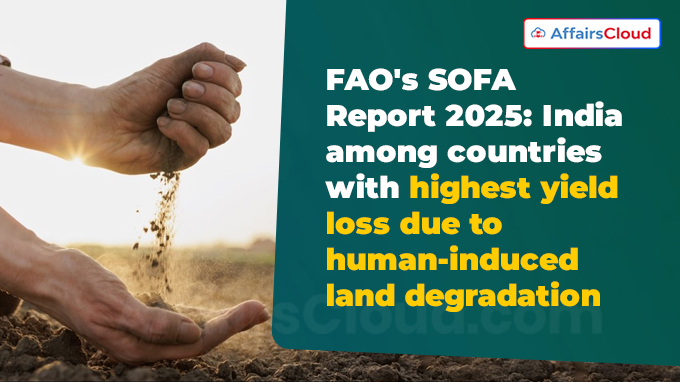In November 2025, the Food and Agriculture Organisation (FAO) released its latest report titled ‘State of Food and Agriculture (SOFA) 2025: Addressing Land Degradation Across Landholding Scales’ during an event held at its headquarters in Rome, Italy. The report highlights that nearly 1.7 billion people live in areas where crop yields are declining due to human-induced land degradation, posing a growing threat to agricultural productivity, food security, and natural ecosystems.
- The report notes that Eastern and Southern Asia face the greatest land degradation impacts, with India ranking among the countries with the highest human-induced crop yield losses.
Exam Hints:
- What? Release of SOFA 2025 Report
- Released by: FAO
- Tile of Report: ‘SOFA 2025: Addressing Land Degradation Across Landholding Scales’
- People Affected: ~1.7 billion globally living in degraded cropland areas
- Regions Most Affected: Eastern and Southern Asia (including India)
- Global Deforestation: Agriculture accounts for ~90% of forest loss
- Total Area Declined under Agriculture: 78 Mha
About SOFA 2025:
Overview: Published annually by FAO, the report examines how human-induced land degradation affects crop yields, highlights global vulnerability hotspots, and connects these losses to poverty, hunger, and malnutrition.
Approach: The report has used a debt-based approach, comparing current values of 3 key indicators: soil organic carbon, soil erosion, and soil water, against conditions that would exist without human activity.
Global Focus: The international community has recognised ‘land degradation’ as a critical global challenge, with over 130 countries pledging to achieve Land Degradation Neutrality (LDN) under United Nations Convention to Combat Desertification (UNCCD).
- The report has outlined key contributors for land degradation: deforestation, overgrazing, and unsustainable cropping and irrigation practices.
Key Findings of SOFA 2025:
Key Driver of Global Deforestation: As per the report, Agriculture continues to be the key driver of global deforestation, accounting for approximately 90% of forest loss.
Reverse of Land Degradation: The report has suggested that by reversing just 10% of human-induced degradation on existing croplands like: by adopting sustainable land management practices, could help in restoring enough production to feed an additional 154 million people annually.
- The research and analysis has further projected that restoring abandoned croplands to productive use could possibly feed between 292 and 476 million people.
Disparity in Land Use for Agriculture: Global cropland increased by 78 million hectares, while permanent meadows and pastures decreased by 151 million hectares, resulting in a net decline of agricultural land by 2% (~78 Mha).
Yield Losses by Income Groups: The report highlighted simulated yield losses from a 1% increase in accumulated land degradation in absolute terms by income groups.
- So, Upper-Middle-Income Countries (UMICs) saw the greatest absolute losses at nearly 2 million tonnes per year; followed by Lower-Middle-Income-Countries (LMICs); Higher Income Countries (HICs); and Lower-Income-Countries (LICs).
Total Land Abandoned: The report also revealed that due to land degradation, around 3.6 mha of crops were abandoned annually.
Vulnerability Hotspots: The report noted that the most severe overlaps occur in Southern Asia and Sub-Saharan Africa region, where degraded lands overlaps with high poverty rates and childhood stunting.
- It showed that overall; 47 million children under the age of 5 suffering from stunting live in hotspots where significant yield losses are mainly attributed by land degradation.
Variation in Farm Size: Of the world’s nearly 570 million farms, 85% are smaller than 2 ha and cultivate only 9% of total farmland.
- While, 0.1% of farmland over 1,000 ha (especially in Africa and Asia) control about half (50%) of all agricultural land.
Contribution of Small Farm-holders: The report noted that despite facing persistent constraints like: limited access to land, credit inputs, technology and markets, the world’s 500 million small farm-holders contributed significantly in global food supply i.e. nearly 16% of global dietary energy, 12% of proteins and 9% of fats derived from crops.
India’s Land Degradation Challenge:
Regional Impact: Eastern and southern regions are most severely affected, driven by high population density and intensive farming practices.
Key Causes: Major contributors include soil erosion, nutrient depletion, deforestation, and excessive irrigation.
About Food and Agriculture Organisation (FAO):
It is of the specialized agencies of the United Nations (UN), to make international efforts to combat hunger and to achieve food security for all.
Director-General (DG)- Qu Dongyu
Headquarters- Rome, Italy
Established- 1945




